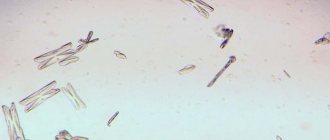Urine is a liquid that removes waste products from the body. During its normal functioning, urine has yellow shades of varying intensity, is absolutely transparent and has a weak, almost imperceptible ammonia odor. The saturation of the shade of urine, its tint in unusual colors and slight clouding, in most cases, are caused by completely natural and harmless reasons, for example, medications, food and even physical activity. But regarding cases where, in addition to cloudiness of urine, it acquires a persistent unpleasant odor, this is most likely caused by dangerous pathologies of the body that require immediate intervention by a specialist.
If noticeable changes in the color, clarity, and odor of your urine do not return to normal within 5 to 6 days, be sure to consult your doctor.
External factors causing foul-smelling urine
As mentioned above, the causes of the strong smell of urine can be completely harmless and natural. More on this below.
Unbalanced diet. Urine loses its natural clarity and acquires a pungent odor with excessive consumption of foods rich in animal proteins. Spicy and salty foods can also cause such manifestations. Excessive indulgence in alcohol, especially beer, also often leads to cloudy urine and a foul odor.
Drug influence . Some medications, as a side effect, lead to a sharp change in the composition, and therefore the smell and color of urine. Such drugs primarily include antibiotics of the ampicillin and ciprofloxacin groups and B vitamins. In addition to these drugs, any other drugs that contain strong coloring pigments can lead to the release of cloudy urine. As a rule, this refers to a group of drugs synthesized artificially.
Natural reasons for the appearance of foul-smelling urine include a shift in water balance towards dehydration of the body. Lack of moisture leads to an increase in the concentration of urine, which is manifested in its noticeable darkening and a strong ammonia odor.
These factors can be called harmless only with some stretch, since prolonged exposure to them, sooner or later, may well cause a problem with nature that is already pathological in nature, so it is worth remembering that health and a healthy lifestyle are related concepts.
Treatment
Treatment for cloudy urine will depend on the underlying cause.
- Dehydration
: Treating dehydration can be as simple as drinking more fluids and eating fluid-rich foods. Severe dehydration may require hospitalization. - UTI
: Most UTIs respond well to antibiotics. In severe cases, a person may need intravenous medications. - STIs
: Treatment will depend on the type of STI. Infections like gonorrhea and syphilis respond well to antibiotics. - Kidney stones
: Many stones pass naturally. Your doctor may prescribe pain medication if the stones are very painful. For larger stones, medications or shock wave therapy are prescribed to break them into small pieces. Very large stones may require surgery. - Vulvovaginitis
: Your doctor may recommend antibiotics, antifungals, or antivirals to treat and relieve symptoms. - Prostatitis
: Prostatitis may go away without treatment. If the infection is caused by bacteria, antibiotics may help treat symptoms. - Diabetes
: Kidney problems that occur with diabetes may require frequent urine tests to check for kidney problems. The person will also need treatment for diabetes.
Reasons for changes in the smell of a pathological nature
Most often, urine loses its natural color and odor as a result of infection of the genitourinary tract by pathogenic microorganisms. Most often, cystitis, urethritis and pyelonephritis are diagnosed, in which the excreted urine loses its transparency (becomes cloudy) and acquires a pungent ammonia odor. The symptoms of these diseases are as follows:
- Pain in the lower abdomen;
- Impaired urination – frequent urges that do not lead to complete relief;
- Painful sensations during bowel movements.
Regarding cystitis, it is worth noting that it is not always caused by infection. It can occur as a result of taking medications that irritate the mucous membrane of the bladder. Urine, with cystitis of this etiology, has a pronounced “pharmacy” odor.
The smell of rot is a sure sign of inflammatory processes in the genitourinary system, aggravated by the occurrence of suppuration and even fistulas. The appearance of such a symptom should not raise any doubts - immediately consult a doctor.
In the male half of the population, one of the most common pathologies is prostatitis. Its symptoms are expressed by an unpleasant, pungent odor of urine, difficulty urinating and the occurrence of pain. Advanced prostatitis can cause problems with sexual function and even prostate swelling, so at the slightest symptoms, consult a doctor immediately.
The occurrence of a strong odor in urine in women can be caused by a painful imbalance of the vaginal microflora. This can be either normal - postpartum changes, or painful - venereal and other infectious lesions.
Topical diagnosis for cloudy urine
For the purpose of topical diagnosis, a two-glass test is performed.
A man urinates into one vessel, releasing an initial portion of urine there. Then immediately releases the remainder into another container. Both portions of urine are examined.
If the urine of men is cloudy in the first portion, this speaks in favor of urethritis or prostatitis. Because the pus is washed away with the first stream.
If this is discharge accumulated in the urethra, then there will be no changes in the 2nd portion. If cloudy urine is detected in men in the second portion, this indicates damage to the structures of the urinary system.
The bladder or kidneys may be inflamed. A three-glass test may also be performed. Its essence is similar.
Only a man urinates not in two, but in three “glasses.” In the first and third - a little, the bulk of the urine - in the second container. Then the predominance of leukocytes in the first portion indicates urethritis or prostatitis. The last portion is about cystitis. If turbidity and pus are detected in all portions, this speaks in favor of kidney damage.
The data from a three-glass urine sample are indicative only. They are not the basis for making any diagnoses.
But this study is completely unburdensome for the patient. And it allows the doctor to plan a plan for further examination.
Other problems
Diseases that produce cloudy, foul-smelling urine are not only of an infectious nature. There are more serious and systemic diseases. Below are some of them.
Diseases leading to changes in urine odor caused by metabolic dysfunction
The smell of fish. This odor is caused by trimethylamine, which is excreted in the urine. This pathology is characteristic of the disease trimethylaminuria. It causes serious imbalances in metabolism and accumulation of the mentioned substance in the urine, which causes this unpleasant odor.
The mouse smell of urine causes a disease of a genetic nature - phenylketonorase. When it occurs, excessive accumulation of phenylalanine occurs in tissue cells, which is excreted in the urine, which leads to a characteristic odor.
The urine smell of maple syrup or burnt sugar causes a disease called leucinosis. It leads to a significant decrease in enzyme formation activity and insufficient oxidation of amino acids. The disease is of a genetic nature - it is inherited and manifests itself almost from the first days of a child’s life. Treatment is maintenance therapy and is carried out immediately after diagnosis.
In addition to the cases described, others may occur, leading to the release of cloudy urine with an unpleasant odor - sweat, mold, rotten cabbage, beer and even sulfur. Any such manifestation is a reason to undergo examination.
Diabetes
A clear sign of this disease is urine with a strong acetone-tinged odor. Associated symptoms:
- Thirst;
- Dry skin;
- Weight loss;
- Leg muscle cramps;
- Polyuria.
Similar symptoms are sometimes observed in a healthy woman during pregnancy. This is caused by the development of so-called gestational diabetes due to pregnancy intoxication of the body.
Water imbalance
In case of insufficient moisture intake, with an increase in body temperature, heavy sweating and during fasting, a state of dehydration occurs, in which the concentration of urine increases greatly, and this leads to the appearance of an unusual - unpleasant odor.
What to do and how to treat?
If cloudy urine is the result of an infectious bacterial disease, first of all a course of antibacterial therapy is prescribed, with the help of which it will be possible to destroy the pathogen and stop the inflammation. Antibiotics such as Monural or Nitrofurantoin are used. For urolithiasis, conservative treatment is prescribed, in which the medications “Canephron”, “Enatin” or “Olimethin” are prescribed. If such therapy does not produce results, the stones are crushed using a laser. When cloudy urine is caused by non-pathological factors, the doctor will advise you to improve your diet, normalize your drinking regime, get rid of bad habits, and lead a healthy lifestyle.
prourinu.ru
Change in the smell of urine in a child
In an infant, the color, smell and transparency of urine do not always indicate the state of his own body. Often these factors are influenced by the diet of the nursing mother, changing the baby’s usual food or adding complementary foods, and as the child grows older, these factors lose relevance. The body of a 2-3 year old child becomes completely autonomous and if the usual color and smell of urine is disturbed, the same problems are diagnosed as in mature people.
Often, darkening of a child’s urine is caused by colds and others, leading to an increase in body temperature, which in turn leads to dehydration. In this situation, you need to ensure increased drinking and bring down the temperature to normal. After the active phase of the disease has passed, the urine will most likely return to normal, but if this does not happen, you should contact your pediatrician.
The main causes of cloudy urine
The etiology of the appearance of cloudy urine is the influence of external causes that are safe for humans, and the appearance of diseases that change the urine. If left untreated, the disease can harm the genitourinary system and lead to infertility.
Safe reasons for cloudy urine
Causes are considered safe, after which the body is fully restored.
- Dehydration. It may be caused by a hot climate, lack of water consumption, drinking only sweet carbonated drinks, or eating foods containing a large amount of salts. Frequent trips to the sauna or bathhouse cause severe sweating, and the amount of body fluid decreases. If it is not replenished, dehydration will occur. When it comes to babies, mothers think that breast milk is enough for them to drink. But this is not true, it contains a small part of water and a lot of nutrients.
- Daily nutrition. One-time use does not lead to changes in the clarity of urine; the product must enter the human body constantly. If the diet contains excessive amounts of carrots, beets, or chemical dyes, the urine will change color and a cloudy sediment will begin to appear. Fermented milk products and fish in large quantities lead to a decrease in pH, and cloudy urine may appear.
- Increased time for transferring a urine container to the laboratory. Cloudy urine with sediment appears, foam disappears. The same reasons occur when urine is stored in the refrigerator for more than 3 hours. If the patient urinates in a contaminated container, the urine will become opaque.
- Lack of vaginal occlusion in women during urine collection. Bacteria contained in the vagina enter the fluid, causing it to change.
- Cloudy urine after childbirth.
- Use of medications. The doctor warns patients that all medications should be discontinued when preparing for the test. If this is not possible due to health reasons, you must notify the laboratory assistant and the attending physician.
The difference between these causes and pathological ones is that when the provoking factor is canceled, the body will recover. The urine status will return to normal.
Pathological causes of cloudy urine
Causes that need to be treated to eliminate cloudy urine include:
- glomerulonephritis, elonephritis, renal failure;
- urolithiasis disease;
- cystitis, urethritis, prostatitis, vaginitis, endometritis.
Their difference from safe reasons is that in addition to changes in urine analysis, an adult has symptoms of diseases of the gastrointestinal tract, kidneys, liver and other organs. This includes:
- the patient is unwell: lethargy, pallor;
- subfibrillation (change in body temperature up to 37.5 degrees);
- soreness in the back or abdomen;
- dyspeptic disorders: nausea, vomiting, diarrhea, constipation.
Urine with a pungent odor - what to do?
If you notice that your urine has become cloudy and has acquired an unusual smell, first of all, analyze your diet and remember what medications you took for 3-4 days before the changes were detected. It is possible that the reasons lie in these factors. After normalizing the diet and stopping taking honey. medications, the situation should return to normal on its own within a few days. If this does not happen, the urine is still cloudy, which may be due to illness. You should contact a urologist, who in turn may advise you to consult an endocrinologist, geneticist or nutritionist.
https://www.youtube.com/watch?v=9ZecKpuhaEE
Cases when cloudy urine is normal
If you suddenly see cloudiness in your urine and the appearance of a white sediment or flakes in it, or it turns white, do not panic ahead of time. It is quite possible that this is not a symptom of any disease at all. Normally, the urine of any healthy person can form sediment when stored for a long time. Mineral substances that are in the urine crystallize and precipitate over time and from a decrease in temperature. This makes the urine cloudy, white, and mixed with flakes. That is why for analysis you should take only the morning portion of urine, collected no later than two hours before delivery.
Cloudiness, flakes, and white urine are also possible as a result of dehydration. This often happens in the summer, after intense physical activity, visits to saunas and baths. These changes do not require special treatment - you just need to drink enough fluid (at least 2 liters per day). Various herbal teas, non-carbonated mineral water, fruit drinks and the like are perfect for this.
We should not forget about proper, balanced nutrition. Very often, cloudy, white urine with white flakes appears after eating salty, spicy foods, or a predominance of meat dishes in the diet. All this puts a lot of pressure on the kidneys, which causes their failure and changes in urine.
Here it would not be amiss to mention excessive consumption of alcohol, toxic substances and drugs. These substances destroy the structural unit of the kidney - the neuron, as a result of which it functions worse.
Turbid urine: general clinical examinations
Blood and urine tests provide indicative results. They help the doctor decide on a further examination plan.
A clinical blood test may reveal signs of inflammation. This is leukocytosis, increased ESR.
A biochemical blood test determines renal dysfunction. An increased level of creatinine indicates a lack of their function.
Some metabolic abnormalities can be detected. For example, an increase in uric acid levels speaks in favor of gout. With this pathology, the urine becomes too acidic and urate stones form. Turbidity of urine is caused by the excretion of urate salts.
What does the urine of a healthy person look like?
Urine is a yellow liquid that is secreted by the kidneys. It occurs due to the filtration of blood serum in the renal glomeruli and the absorption of metabolic products in the nephrons - the renal tubules. The biochemical composition of urine correlates with the composition of blood. Therefore, its transparency reflects the performance of the kidneys and urinary tract.
When assessing the state of urine, several physical indicators are taken into account:
- Quantity. Daily diuresis is up to 80% of the liquid drunk per day, which corresponds to 1.5-2 liters of water. A decrease or increase in the amount of urine indicates kidney dysfunction and urinary tract obstruction.
- Transparency. Normally the liquid is clear. Urine with sediment becomes cloudy, sometimes large flakes form in it. Impurities contain pathogenic bacteria, epithelial cells, mucus or inorganic compounds - oxalates, urates, phosphates (kidney stones).
- Turbidity. The cloudy color is the result of the precipitation of various impurities, which is often observed with genitourinary infections.
- Smell. Normally, the smell is weak. If it intensifies or becomes unpleasant - sour, ammonia, acetone - this indicates ill health.
- Foaminess. When shaken, the liquid does not foam. Persistent foam is a consequence of metabolic disorders, hepatitis, and cardiovascular diseases.
In some cases, cloudy urine occurs due to improper preparation for the test or violation of the rules for storing it after collection. Therefore, if deviations in the physical parameters of the biomaterial are detected, a repeat analysis is performed.
Etiological diagnosis of cloudy urine
Often the cause of cloudy urine in men is infection. It can be located in the urethra. If urethritis is suspected, smears are taken. They are examined under a microscope.
The detection of a large number of leukocytes in the field of view indicates that an inflammatory process is taking place. It is not always possible to find out what pathology caused it using bacterioscopy.
Gonococci and candida may be detected in the smear. Theoretically, trichomonas can also be detected.
In practice, they are visualized on a smear in men quite rarely, even with existing trichomoniasis. If urethritis is confirmed, PCR may be performed to determine its cause. A study is carried out for infections that are most common. These are gonorrhea, chlamydia, trichomoniasis. They are the ones most likely to become a source of inflammation.
Using PCR, not only the smear is examined, but also:
- urine
- prostate secret
- ejaculate
- any other biomaterial, depending on the expected location of the pathogen
Men are often prescribed urine culture for flora.
This diagnostic test allows you to identify the causative agents of infections - nonspecific bacteria. Normally, urine is sterile.
The presence of contaminating flora in the material in small numbers is allowed. Because it can enter urine samples from the upper urethra. Those, in turn, are populated by microorganisms that live on human skin.
But in case of contamination there are very few bacteria. If there is inflammation of the urinary tract, then during the study the doctor receives high quantitative indicators.
Exceeding the level of 10 to 4 CFU indicates an active infection. For E. coli, the pathogenicity threshold is slightly higher - 10 to 5 CFU.










